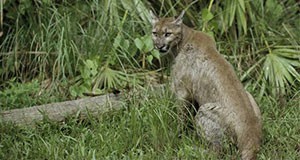Abstract
Endangered Florida panthers live and breed on state and federal lands in south Florida, but they are a wide-ranging species, and the habitat available to them on public lands is not enough for them to thrive and recover. The 2008 Panther Recovery Plan by the US Fish and Wildlife Service requires that habitat for the panther be conserved on both public and private lands throughout the state. Private rangelands in southwest and south central Florida provide important habitat and prey for the Florida panther. These lands also play a key role in conserving other native species like gopher tortoises, bob white quail, turkeys, deer, vultures, scrub jays, cranes, black bears, and bobcats. Unfortunately, these rangelands are under increasing development pressure as the human population in Florida continues to grow. Multiple policy approaches have been put in place by local, state, and federal governments to address habitat loss and secure natural resources in Florida for our panthers. This 5-page fact sheet provides a brief overview of existing regulatory and voluntary approaches to help conserve the Florida panther on private lands. Written by Elizabeth F. Pienaar and Melissa M. Kreye, and published by the Department of Wildlife Ecology and Conservation, September 2016.
References
FPPP. 2014. Florida Panther Protection Program. Retrieved April 14, 2015 from http://www.floridapantherprotection.com/
FPRIT. 2014. "Incentivizing Panther Conservation on Working Lands in the Panther Focus Area." Retrieved July 15, 2015 from http://www.fws.gov/verobeach/FloridaPantherRIT/20150218%20Florida%20Panther%20PES%20Pilot%20Program.pdf
FWC. 2010. "Questions and Answers - Critical Habitat for the Florida Panther." Retrieved on April 14, 2014 from http://www.fws.gov/verobeach/MammalsPDFs/QuestionsAndAnswersCriticalHabitatfortheFloridaPanther.pdf
Kaplowitz, M. D., P. Machemer, and R. Pruetz. 2008. "Planners' experiences in managing growth using transferable development rights (TDR) in the United States." Land Use Policy 25, 378-387. https://doi.org/10.1016/j.landusepol.2007.07.004
Kautz, R., R. Kawula, T. Hoctor, J. Comiskey, D. Jansen, D. Jennings, J. Kasbohm, F. Mazzotti, R. McBride, L. Richardson, and K. Root. 2006. "How much is enough? Landscape-scale conservation for the Florida panther." Biological Conservation 130: 118-133. https://doi.org/10.1016/j.biocon.2005.12.007
Kreye, M., and E. F. Pienaar. 2015. "A critical review of efforts to protect Florida panther habitat on private lands." Land Use Policy. 48: 428-436. https://doi.org/10.1016/j.landusepol.2015.06.018
Kreye, M, E. F. Pienaar, R. K. Boughton, and L. Wiggins. 2015. Safe Harbor Agreement: A Regulatory Assurance under the Endangered Species Act. WEC358. Gainesville: University of Florida Institute of Food and Agricultural Sciences. http://edis.ifas.ufl.edu/uw403
Machemer, P. L., and M. D. Kaplowitz. 2002. "A framework for evaluating transferable development rights programmes." Journal of Environmental Planning and Management, 45(6), 773-795. https://doi.org/10.1080/0964056022000024334
Main, M. B., G. M. Allen, and M. E. Sunquist. 2004. Florida's Large Carnivores. WEC 183. Gainesville: University of Florida Institute of Food and Agricultural Sciences. Retrieved April 14, 2015 from http://edis.ifas.ufl.edu/uw201 https://doi.org/10.32473/edis-uw201-2004
McConnell, V., E. Kopits, and M. Walls. 2003. How well can markets for development rights work? Evaluating a farmland preservation program. Discussion Paper 03-08, Resources for the Future, Washington, D.C. 50 pp.
Pienaar, E. F., and E. C. Rubino. 2014. Habitat Requirements of the Florida Panther. WEC 345. Gainesville: University of Florida Institute of Food and Agricultural Sciences. Retrieved on April 14, 2015 from http://edis.ifas.ufl.edu/uw390
Pienaar, E. F., M. M. Kreye and C. E. Jacobs. 2015. "Conflicts between cattlemen and the Florida panther: insights and policy recommendations from interviews with Florida cattlemen." Human Ecology - An Interdisciplinary Journal, 43(4), 577-588. https://doi.org/10.1007/s10745-015-9765-x
RLSA. 2015. Rural Lands Stewardship Area. Downloaded on April 4, 2014 from http://www.colliergov.net/index.aspx?page=1515
Schaefer, J., J. Tucker, and M. McGuire. 2012. Laws that Protect Florida Wildlife. WEC 48. Gainesville: University of Florida Institute of Food and Agricultural Sciences. Retrieved on April 14, 2015 from http://edis.ifas.ufl.edu/uw076
Thatcher, C. A., F. T. van Manen, and J. D. Clark. 2009. "A habitat assessment for Florida panther population expansion into central Florida." Journal of Mammology. 90(4), 918-925. https://doi.org/10.1644/08-MAMM-A-219.1
USFWS. 2003. Guidance for the Establishment, Use, and Operation of Conservation Banks. Memorandum to the Regional Directs (Regions 1-7) and the Manager (California Nevada Operations). United States Department of the Interior Fish and Wildlife Service. Washington, D.C. 19 pp.
USFWS. 2008. Florida Panther Recovery Plan (Puma concolor coryi), Third Revision. U.S. Fish and Wildlife Service. Atlanta, Georgia. 217 pp.
USFWS. 2011. "Habitat Conservation Plans Under the Endangered Species Act." U.S. Fish and Wildlife Service Endangered Species Program. Arlington, Virginia. Retrieved on July 13, 2015 from http://www.fws.gov/endangered/esa-library/pdf/hcp.pdf.
USFWS. 2013. "ESA Basics." Retrieved on July 13, 2015 from https://www.fws.gov/endangered/esa-library/pdf/ESA_basics.pdf
van de Kerk, M, D. P. Onorato, and K. O. Madan. 2015. The Florida Panther: Past, Present and Future. WEC 357. Gainesville: University of Florida Institute of Food and Agricultural Sciences. Retrieved on April 14, 2015 from http://edis.ifas.ufl.edu/uw402

